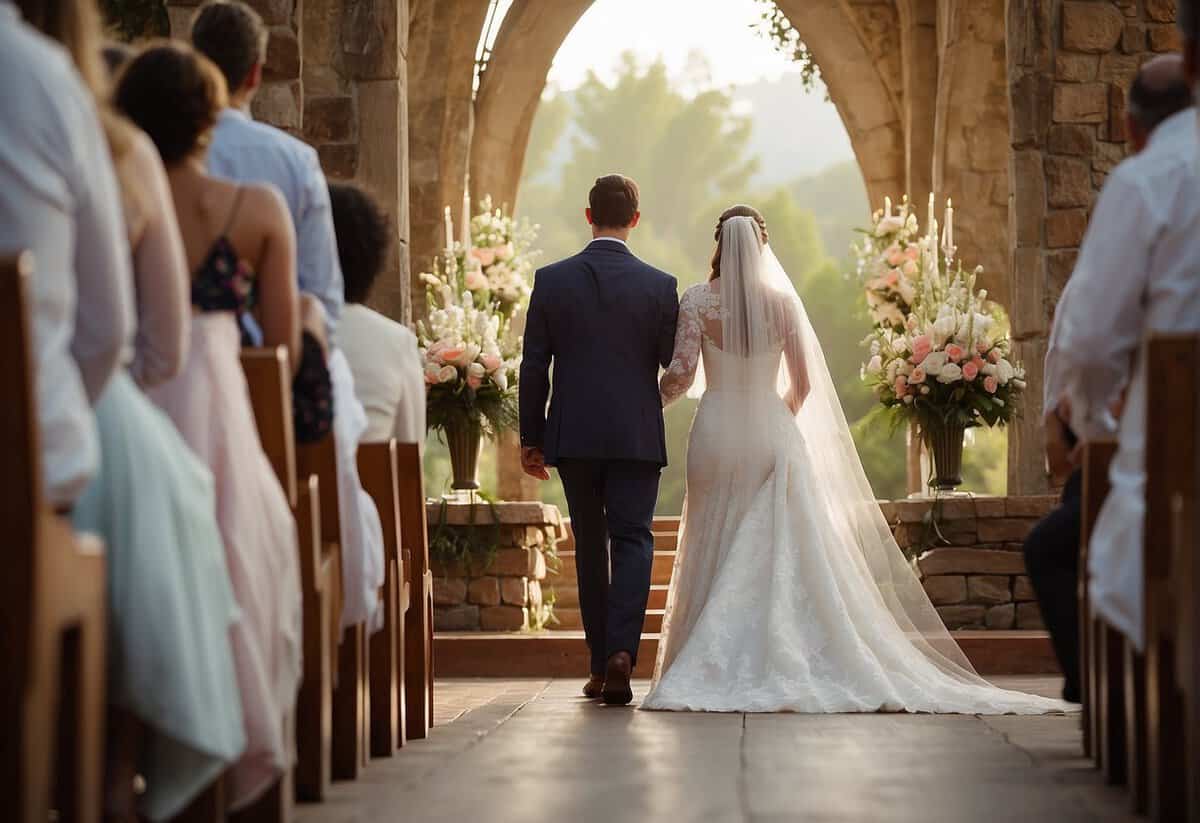Who Gives the Bride Away When Parents are Divorced? Navigating the Aisle with Grace
When it comes to the tradition of giving the bride away during a wedding ceremony, the presence of divorced parents can introduce a sensitive dynamic. Historically, the father of the bride would be the one to escort her down the aisle and ‘give her away’ to the groom, symbolizing the transfer of guardianship. However, in modern weddings, this practice has evolved to be more inclusive and emotionally considerate. If you’re planning your wedding with divorced parents, there are several respectful ways to approach who escorts you down the aisle, ensuring that your family dynamics are honored and that the ceremony reflects your personal values.

The wedding ceremony can be customized to fit the unique contours of your family situation. Whether you choose to be escorted by one parent, both, or another important figure in your life, the decision is a personal one that reflects your relationships and the role you wish your loved ones to play on your special day. Additionally, as customs change, more couples are opting for creative alternatives to the traditional escort, providing opportunities for both parents to be involved, regardless of their marital status. It’s important to communicate openly with all parties and navigate emotions carefully to maintain harmony and preserve the joyous spirit of the occasion.
Key Takeaways
- The tradition of giving away the bride can be adapted to accommodate modern family dynamics.
- A bride can choose how to be escorted down the aisle, reflecting personal relationships.
- Communication between all parties is critical to navigate emotions during the wedding.
Determining Who Escorts the Bride

When planning your wedding, it’s important to consider who will have the honored role of escorting you down the aisle, especially in a situation where your parents are divorced. This decision can reflect your personal relationships and the dynamics of your family.
Family Considerations
In the context of a wedding where the bride’s parents are divorced, family dynamics play a crucial role in deciding who will escort you in your walk down the aisle. If you maintain a strong connection with your father, he may be the natural choice. However, it’s equally valid if your mother or both parents together fit this role for you. For some brides, a stepfather has taken on a significant paternal role, and including him could be a way to honor that relationship. An example of such inclusiveness might be having both your biological father and stepfather escort you, thereby respecting and acknowledging your bond with both. Alternatively, if the relationship with your father is strained or he is not present in your life, your mother can take on this role, symbolizing her support and love.
Respecting All Parents
It’s essential to navigate this sensitive decision with care to respect all parental figures involved. If you wish to honor all your parents without choosing sides, a thoughtful way might involve each parent playing a part in the ceremony. For instance, one parent could escort you halfway down the aisle, while the other completes the journey with you to the altar, signifying their unified support for you. This shows equal recognition and prevents any feelings of exclusion. If the concept of ‘giving away’ feels outdated, you can reframe the tradition to a focus on support and accompaniment, which might be more comfortable for everyone involved.
Alternative Escort Options
If traditional options don’t appeal to you, numerous alternative escort options are at your disposal. You may choose a close friend, siblings, or another family member who has significantly impacted your life. For some brides, walking down the aisle alone is a powerful statement of independence and self-representation. Alternatively, including a pet or having children from the family lead the way are also heartfelt choices. Ultimately, this walk is a symbolic journey, and the right escort is whoever makes you feel cherished and supported in this momentous step in your life.
Wedding Ceremony Details

When planning your wedding ceremony, considering the nuances of processionals and seating, especially when parents are divorced, can help ensure a smooth and inclusive celebration.
Processional Arrangements
Your ceremony processional is a significant tradition where the order of entrance can be tailored to your family dynamics. If you have a step-parent you wish to include along with your divorced parents, you might opt for a modified entrance. Some couples choose to have both fathers walk the bride down the aisle, which is a respectful gesture acknowledging their roles in her life. Alternatively, stating “her family” when asked who gives the bride away is an inclusive approach.
Seating Plans
Seating plans require special attention to avoid any discomfort among your wedding guests. Typically, the front row is reserved for immediate family members. You could arrange the seating in a way that each parent has their own space, designating equal prominence without the expectation of them sitting together. For instance, reserve the first two rows on each side, placing your parents separately but within the same proximity to the sweetheart table.
Ceremony Rituals
The rituals during your wedding ceremony can be adapted to include all members of your blended family. Instead of the traditional ‘giving away’ part, the officiant could welcome the guests on behalf of both parents, ensuring no one feels excluded. Remember that the most important aspect is that these moments reflect your values and the love you share with your family.
Navigating Emotions and Relationships

When planning your wedding, honoring the feelings of your loved ones while keeping the peace is essential. Your divorced parents may have different comfort levels, and there might be new partners to consider in the backdrop of cascading family dynamics.
Handling Divorced Parents
Be Mindful: Acknowledge each parent’s feelings with respect and empathy. If your parents are divorced, consider their individual relationships with you and whether they would find joy and love in being part of the moment you are given away. If they both wish to be involved, perhaps they could each play a role, such as one walking you halfway down the aisle and the other taking over from there. For guidance on how to approach this, The Knot offers thoughtful insights on involving divorced parents.
Incorporating New Partners
New Partners, New Dynamics: If your parents have remarried, you’ll need to consider how to include their new partners respectfully. Evaluate your relationship with each step-parent and how their presence may affect the day’s logistics. For instance, a step-parent could do a special reading during the ceremony, symbolizing their support and the union of families. Unbridely provides some practical advice on wedding planning with step-parents.
Celebrating Family Unions
Celebrate Togetherness: The focus is on unity and the celebration of family. It’s a day that should pulse with love and respect. Look for ways to actively involve all parents and communicate that each role is meaningful. Whether it’s a parent of the bride offering a toast or participating in a blended family dance, identified by Brides as a way to prepare divorced parents, these gestures can deepen the sense of kinship and support for your new beginning.
Customs and Modern Alternatives

Navigating the nuances of who gives away the bride when parents are divorced can be sensitive but is ultimately about love and support. This section helps you understand the historical importance and offers modern alternatives that honor all parties involved.
Historical Significance
Traditionally, the father of the bride took the role of escorting his daughter down the aisle, symbolizing a transition of “care” from her parents to her spouse. In history, this custom also had roots in the idea of a bride being “transferred” as property. However, modern interpretations have shifted to view this act as a display of family love and support rather than a transaction.
Reimagining Tradition
In a modern context, you have the flexibility to tailor traditions to better fit your family dynamics and personal beliefs. For instance, alternative wordings in ceremonies might involve both parents with phrases like “Who supports this woman in her marriage to this man?” This inclusive language reflects a more egalitarian perspective, recognizing that giving away the bride is a symbol of blessing rather than ownership.
Personalized Ceremony Ideas
Personalizing your ceremony could mean having a step-parent, mother, sibling, or even both parents share in the role. Gender variations in this practice are also common, as some ceremonies feature the groom being escorted as well. If traditional aspects don’t resonate with you, consider the option to skip it entirely. Walking solo can empower you and symbolize your autonomy. For same-sex weddings, couples often choose to walk together or with multiple family members to emphasize love and support equal from all sides.
Remember, the key is to create a moment that feels genuine and joyful for everyone involved.
Frequently Asked Questions

Navigating the traditions of who gives the bride away can be complex when parents are divorced. Your wedding ceremony can still be special and inclusive with a modern twist on these traditions.
What are some appropriate alternatives to ‘Who gives this bride away?’ in a wedding ceremony?
Instead of the traditional phrase, consider wording that includes all parents or guardians, like “Who supports this woman in her marriage?” There are also options that honor individual relationships, such as “her family” or simply involving the entire assembly with “Do you, the friends and family of the bride, support…”
How can a bride incorporate a stepfather in the ceremony when her biological parents are divorced?
A bride can involve her stepfather by having both her father and stepfather walk her down the aisle together. Alternatively, the stepfather can be included in different aspects of the ceremony, such as giving a speech or being part of a special segment like the ring warming.
What are some humorous sayings or quotes when giving the bride away?
For a touch of humor, phrases like “We/I have been trying to give her away for years, and today we/I finally do!” can lighten the mood. A playful quote such as, “Take her, she’s yours! Just remember: no refunds,” may also bring a chuckle to your guests.
Who typically walks the bride down the aisle when her parents are divorced?
Traditionally, the bride’s father walks her down the aisle, but modern weddings often see the bride escorted by both parents, just her mother, or even walking solo to symbolize independence. The important thing is to choose what feels right for you, whether it be a close family member or a friend.
How should divorced parents handle wedding expenses for their daughter’s ceremony?
Divorced parents might split the wedding expenses equally, contribute based on their financial ability, or follow the daughter’s wishes in how they participate. Open communication and clear expectations are crucial to navigate this delicate topic.
What is the proper wedding etiquette for divorced parents during the ceremony?
Proper wedding etiquette for divorced parents involves being respectful and supportive despite personal differences. They should avoid any actions that might cause tension, such as insisting on sitting together if it is uncomfortable. They might also discuss ahead of time with the couple how to navigate family photos and seating arrangements.

